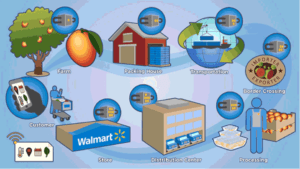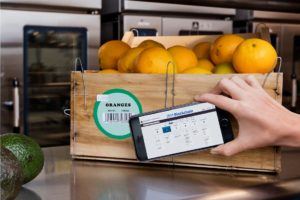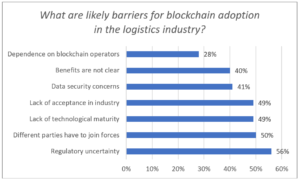From Farm to Store: Walmart Improves Food Safety with Blockchain Technology

Walmart, the world’s largest retailer, has announced a blockchain collaboration with IBM to improve the way food is tracked, transported, and sold to consumers.
Blockchain: The Holy Grail?
“I brought a package of sliced mangoes into my staff meeting. I put it on the desk, and I said to my team, the traceback study starts right now.” Frank Yiannas, Walmart’s Vice President of Food Safety, waited 7 days for his team to track mangoes from farm to store. With blockchain, he has reduced that timeline to 2.2 seconds [1].
Blockchain—the technology at the heart of bitcoin and other cryptocurrencies—could be the solution to traceability issues in food supply chain management [2]. Blockchain refers to a bookkeeping method that “chains” together entries so that they are very difficult to alter [3]. In the case of the food supply chain, all participants—growers, suppliers, processors, distributors, retailers, regulators, and consumers—can gain permissioned access to secure and reliable information about the state of the food for their transactions [4]. From a single receipt, Walmart will be able to uncover farm origin, batch numbers, factory and processing data, expiration dates, and shipping details [5]. As the food supply chain becomes increasingly complex and global, such information is “the holy grail” for Yiannas [3].

Failures of the Current System
The current tracking process uses disparate, manual methods that are inefficient and vulnerable to inaccuracy or fraud [7]. Costs include:
- Human loss of health and life. According to the World Health Organization, every year, an estimated 600 million—almost 1 in 10 people in the world— fall ill and 420,000 die after eating contaminated food [8]. For example, the recent salmonella outbreak linked to Maradol papayas ran rampant for over two months, during which time 220 people fell ill [9]. Use of the blockchain network to trace a contaminated product to its source quickly will help curb the spread of foodborne illnesses.
- Food waste. During outbreak scares, retailers must destroy all products that are, in some way, connected to the contaminated batch. According to Yiannas, “It’s the difference between pulling a few tainted packages and yanking all the spinach from hundreds of stores” [5]. In addition, without accurate shelf life data, retailers tend to discard food that is still fresh. Brigid McDermott, Vice President of Blockchain Business Development for IBM claims, “The more that [retailers] have granular information about particular items, the more that [they’re] able to make smart decisions on how [they] merchandise them” [1].
- Low levels of consumer trust in the food industry. Increasing incidence of food fraud—like the 2013 UK horsemeat scandal—and information asymmetry limit consumers’ ability to identify high quality food [10] [11]. Amid growing demand for food characterized by certain properties (GM, non-GM, ethical, organic, low carbon footprint, subject to religious constraints, etc.), blockchain will satisfy consumers’ desire for more transparency in the food system [2].

Walmart: Next Steps and Recommendations
Walmart has already run blockchain pilots with IBM tracking Chinese pork and Mexican mangoes [12]. In the near term, Yiannas hopes to scale in China, stating last week that all 400 of the company’s stores across China are “in active conversation to accelerate the process” of blockchain. “China is probably the place to scale its adoption as the Chinese government is already interested in tracing [the supply chain of food] and Chinese consumers are so tech-savvy,” he said [13].

McDermott’s “if” is a big one and poses a legitimate concern for the future of blockchain. A recent survey on blockchain in logistics and supply chain management reveals that, of 152 respondents, only two logistics services companies experiment with blockchain today. Most cite regulatory uncertainty and the concern that different parties will have to join forces as barriers to adoption [16].

(777 words)
References:
[1] Walmart, “Outside the Box: Breaking Down Blockchain with Brigid McDermott: VP of Blockchain Business Development & Ecosystem at IBM & Frank Yiannas: VP of Food Safety at Walmart,” June 20, 2017, podcast, https://corporate.walmart.com/outside-the-box-podcast, accessed November 2017.
[2] Fabrizio Dabbene, Paolo Gay, and Cristina Tortia, “Traceability issues in food supply chain management: A review,” Biosystems Engineering, September 20, 2013, via Google Scholar, accessed November 2017.
[3] Nathaniel Popper and Steve Lohr, “Blockchain: A Better Way to Track Pork Chops, Bonds, Bad Peanut Butter?” The New York Times, March 4, 2017, https://www.nytimes.com/2017/03/04/business/dealbook/blockchain-ibm-bitcoin.html, accessed November 2017.
[4] Roger Aitken, “IBM Forges Blockchain Collaboration With Nestlé & Walmart In Global Food Safety,” Forbes, August 22, 2017, https://www.forbes.com/sites/rogeraitken/2017/08/22/ibm-forges-blockchain-collaboration-with-nestle-walmart-for-global-food-safety/#10bcc4b23d36, accessed November 2017.
[5] Olga Kharif, “Wal-Mart Tackles Food Safety with Trial of Blockchain,” Bloomberg, November 18, 2016, https://www.bloomberg.com/news/articles/2016-11-18/wal-mart-tackles-food-safety-with-test-of-blockchain-technology, accessed November 2017.
[6] David Galvin, “IBM and Walmart: Blockchain for Food Safety,” PowerPoint presentation, 2017, IBM Corporation, https://www-01.ibm.com/events/wwe/grp/grp308.nsf/vLookupPDFs/6%20Using%20Blockchain%20for%20Food%20Safe%202/$file/6%20Using%20Blockchain%20for%20Food%20Safe%202.pdf, accessed November 2017.
[7] Karen Lewis, “Blockchain: four use cases transforming business,” Internet of Things (blog), May 25, 2017, https://www.ibm.com/blogs/internet-of-things/iot-blockchain-use-cases, accessed November 2017.
[8] World Health Organization, “Food safety,” October 2017, http://www.who.int/mediacentre/factsheets/fs399/en, accessed November 2017.
[9] Centers for Disease Control and Prevention, “Multistate Outbreak of Salmonella Infections Linked to Imported Maradol Papayas (Final Update),” November 3, 2017, https://www.cdc.gov/salmonella/kiambu-07-17/index.html, accessed November 2017.
[10] Felicity Lawrence, “Horsemeat scandal: the essential guide,” The Guardian, February 15, 2013, https://www.theguardian.com/uk/2013/feb/15/horsemeat-scandal-the-essential-guide, accessed November 2017.
[11] “How the Blockchain Can Revolutionise the Food Industry,” arc-net (blog), April 10, 2017, http://arc-net.io/blog/blockchain-revolutionise-food-industry, accessed November 2017.
[12] Robert Hackett, “Walmart and 9 Food Giants Team Up on IBM Blockchain Plans,” Fortune, August 22, 2017, http://fortune.com/2017/08/22/walmart-blockchain-ibm-food-nestle-unilever-tyson-dole, accessed November 2017.
[13] George Smith, “Chinese consumers to trace food through Blockchain,” New Food Magazine, November 6, 2017, https://www.newfoodmagazine.com/news/45975/chinese-consumers-trace-food-blockchain, accessed November 2017.
[14] Michael del Castillo, “Walmart, Kroger & Nestle Team with IBM Blockchain to Fight Food Poisoning,” CoinDesk, August 22, 2017, https://www.coindesk.com/walmart-kroger-nestle-team-with-ibm-blockchain-to-fight-food-poisoning, accessed November 2017.
[15] Simon Creasey, “The potential for blockchain in the food industry,” Just – Food Global News, October 26, 2017, via ProQuest, accessed November 2017.
[16] Niels Hackius and Moritz Peterson, “Blockchain in Logistics and Supply Chain: Trick or Treat,” 2017, Hamburg International Conference of Logistics, via Google Scholar, accessed November 2017.



This is a very interesting article and I’m excited to see how distributed ledgers are used within the supply chain, and which existing protocols (or new ones) end up being used. A few thoughts —
1. You mentioned the lack of trust in food supply chains. What do you think this stems from? Could it be the use of pesticides etc being understated at the production stage.
2. Do you see the incentives offered via cryptoeconomics being useful here? Is there anything other than speed of traceability that would justify the use of blockchains for food tracking?
3. I worry about the environmental impacts of Walmart’s competitors following a similar approach. Do you see the cost of mining rising to prevent this market from becoming saturated (and consuming a huge amount of energy)?
I am extremely interested to see how transparency and trust technologies like blockchain will influence consumer behavior, and I really enjoyed reading how WalMart is using the tech to remedy important problems.
First, I wonder how this information will be made available to the consumer. For example, let’s say I buy a salad from WalMart. There are likely more than 20 ingredients–am I allowed to see the provenance of each? And trace those supply chains? I suspect that many stores–including WalMart–will be extremely hesitant to share that information, preferring to keep it proprietary to themselves and their supply chains. Publishing supply chain information could potentially give the competition insight that could help to hurt the company.
Second, I wonder whose trust issue we are really solving in using blockchain in this scenario. Do consumers trust WalMart to properly source goods? If so, then the trust question being solved is if the manufacturer (or grower, producer, farmer, etc.) is trustworthy–and I am not sure that blockchain can help that far down the supply chain. At the end of the day, as soon as the blockchain technology must interact with the physical world, trust can be broken–eg, I can swap one crate of oranges for another and switch the barcodes, and you will be none the wiser, regardless of blockchain.
In short, I think there is great potential for blockchain and public ledgers in the food space and WalMart in general. I would caution, though, that companies and consumers need to give the technology a little more thought and decide what level of transparency is appropriate, and whose trust we are truly buying by using blockchain.
I found this article fascinating, particularly from the perspective of a company that was directly involved in the UK horsemeat scandal in 2013. The most significant impact of this scandal was a massive increase on traceability requirements for suppliers. Since the scandal, UK retailers have imposed new obligations on UK suppliers requiring them to be able to trace every component of a food product to the original source within 3 hours of a request. They audit this standard regularly. Obviously, the ability to employ blockchain technology to achieve this would revolutionise the supply chain and dramatically reduce the complexity of this task. However, for me, the biggest challenge in implementing this technology is slim margins in elements of the supply chain for food. This would require co-operation and investment at each stage of the supply chain and the dollar investment required could be prohibitive for some or all players.